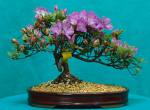When propagating woody plants, the two types are softwood and hardwood.Cuttings (from softwood, or semi-ripe) are taken in late spring or early summer. Cuttings from hardwood are taken in the autumn. If you want to take a cutting from a broad-leaf tree, take a cutting that has several nodes. Be sure to remove the lowest leaves and the growing tip. Remove two-thirds of each leaf if the leaves are large so as to reduce water loss. Use a sharp scissors. This will reduce water loss and increase survival.
To propagate conifers you will need to take heel cuttings. To do this pull down on the shoots until they detach. The heel is the small hardwood material from the branch that comes off with the shoot. Reduce the amount of foliage but leave some foliage as the cuttings will die without any foliage.
Put some soil mix (a gritty mixture which is more than used for seeds) in a seed tray. Use a stick or a chopstick and insert the cuttings into the soil mix. The cutting should be inserted about 1/3rd of their length-make it firm by hand. When finished, water and spray with fungicide to protect from fungi. Place in a shady cool place and cover to keep humidity in. Bonsai Humidity Trays
Akadama is a good Japanese potting soil to use if you would rather use this than a commercial compost. Akadama is really good for root production. Bonsai Soils
Bonsai Boy of NY
I hope you got something out of this blog. Thank you for visiting!






